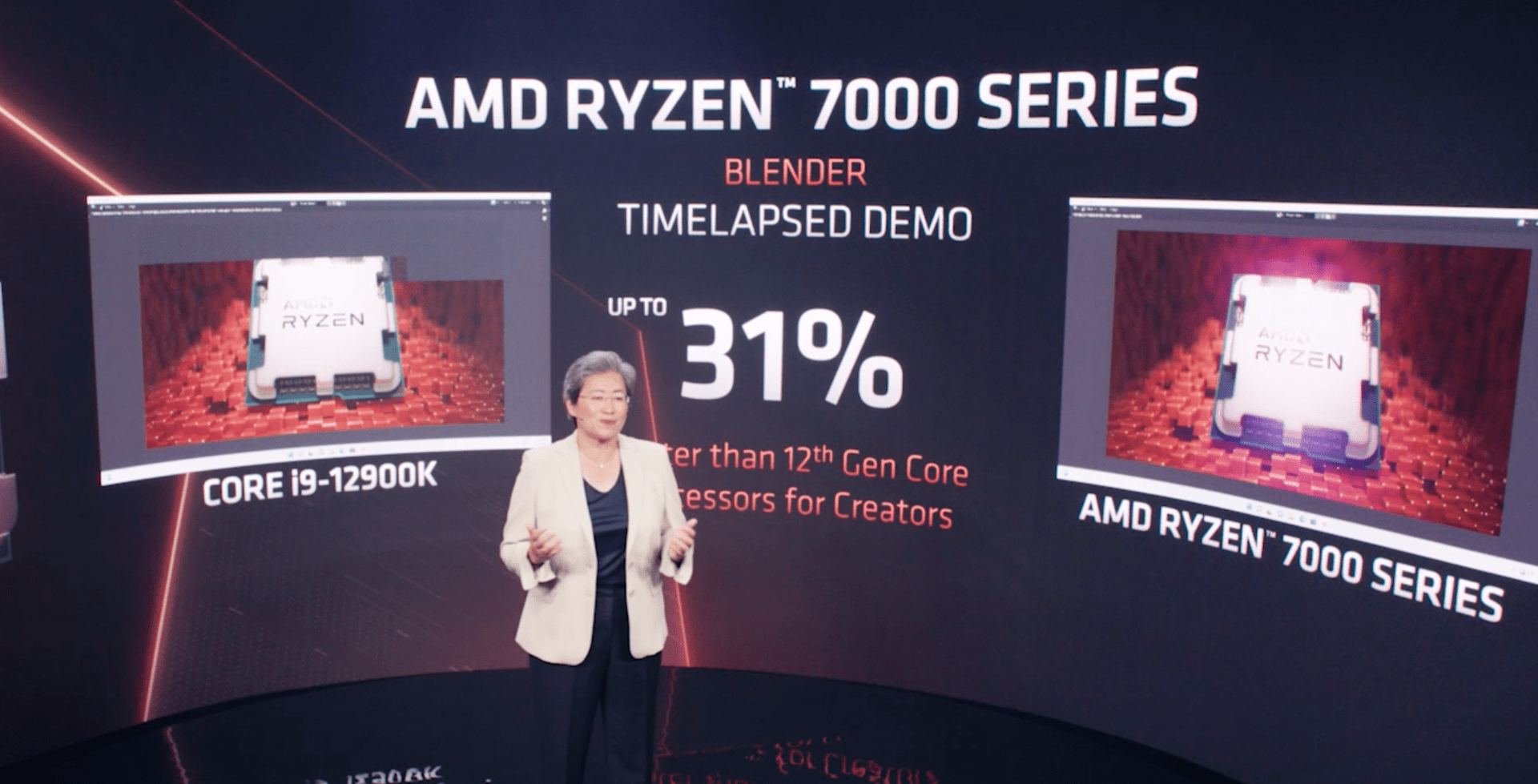AMD Ryzen 7000 unveiled at Computex 2022: The manufacturer promises “over 15 percent” more single-thread performance thanks to increased IPC and higher clock rates of over 5.0 GHz, potentially PCIe 5.0 and always an integrated RDNA-2 GPU. The starting signal for the desktop products in socket AM5 will be given “in autumn” this year.
The Zen 4 cores are faster, but also fast enough?
Robert Hallock, head of technical marketing at AMD, explained ahead of CEO Lisa Su's keynote on Sunday that the “more than 15 percent” surcharge in single-thread performance is the sum of IPC and clock increase.
AMD does not name an isolated IPCgrowth< /h3>
According to information shown today, the clock increases to 5.5 GHz (and more), a Ryzen 9 5950X as the previous clock flagship manages to work stably at around 5 GHz. Exactly this CPU is also the chosen opponent in AMD's own benchmark, whereby the clock of the Ryzen 7000 used remained under lock and key. In the end, AMD has neither mentioned an absolute single-core performance increase (from IPC and clock) nor a specific IPC increase.
In the CineBench R23 1T, Zen 3 CPUs could achieve around 2 percent more performance per 100 MHz more clock. The pure IPC gain through Zen 4 would therefore be surprisingly low against the background of the targeted clock rates and Intel's recently significantly stronger Alder It is extremely difficult to beat the Lake models in this discipline – AMD did not draw a direct comparison in the keynote.
 5.5 GHz in games is not a problem – single core should clock at least the same (Picture: AMD)
5.5 GHz in games is not a problem – single core should clock at least the same (Picture: AMD) However, it remains to be seen how high the IPC increase from Zen 3 to Zen 4 will ultimately be, especially since the exact clock frequency of the sample was not given. However, AMD undoubtedly held back on this point more clearly than in recent years. In the end, however, the manufacturer always had a knack for offering something more in the end, especially since the “>” also suggests this. In multi-core scenarios, the manufacturer again promises to significantly extend the lead over Intel and sent Raphael into the ring with Zen 4 against Alder Lake-S.
Multi-core, an Intel Core i9-12900K will be clearly beaten
In the presented render test, one of the strengths of all AMD CPUs, an Intel Core i9-12900K from the new Ryzen 7000 with 16 cores with only 204 seconds processing time for AMD is more than clearly relegated to 297 seconds for Intels . That's not surprising, in Blender, for example, a Core i9-12900K is already 12 to 15 percent behind a Ryzen 9 5950X. However, the percentage gain seems to be more pronounced here than in single-core scenarios, 31 percent plus is on AMD's credit side in the end.
In view of the increased power consumption, this value is not as high as was speculated in many places in advance and taking into account past progress on the same TDP level.
-
 AMD is significantly faster in Blender (Image: AMD)
AMD is significantly faster in Blender (Image: AMD)
Image 1 of 2
 AMD is significantly faster in Blender
AMD is significantly faster in Blender  Footnotes provide information about AMD's test
Footnotes provide information about AMD's test The Intel Corei i9-12900K is known to be a power guzzler, but AMD confirmed today that their solutions can also be used at up to 170 watts in the future. AMD avoided a concrete definition and it remains to be seen whether 170 watts is the TDP or the maximum power consumption of the CPU in the socket. Until now, the large Ryzen 5000 was specified with a TDP of 105 watts, but could permanently consume up to 142 watts if the cooling allowed it. With Ryzen 7000, the rumor mill recently said that 170 watts was the new maximum TDP and 230 watts was the resulting maximum permissible value. Final confirmation pending.
How fast is Ryzen 7000 with Zen 4?
In the past, AMD's CEO Dr. Lisa Su often gives detailed insights into the performance of a new CPU generation when presenting it. This is not the case with Ryzen 7000 today. The results presented without exact information on the clock rates used do not allow a conclusive assessment. Either AMD doesn't want to show anymore, or AMD can't show anymore.
 More than 5.5 GHz should be reached in games (image: AMD)
More than 5.5 GHz should be reached in games (image: AMD) Under the hood: N5 meets N6 twice< /h2>
As expected, under the new, distinctive heat spreader in the Ryzen 7000 desktop are two CPU dies (CCD) from TSMC's optimized N5 production (which, exactly, remains unclear) and a completely new I/O die (IOD), which at TSMC is manufactured in N6 and no longer at Globalfoundries.
Even the power consumption is on the collar, here the IOD was not a cost despiser until now. Many features of the Ryzen 6000 alias AMD Rembrandt are now also implemented in the IOD, the production of the two solutions is also identical in TSMC N6.
And of course the IOD brings the other two essential features of the platform: DDR5 and PCI Express 5.0. This ensures that the new mainboards are supplied with up to 24 PCIe 5.0 lanes for storage and graphics cards. However, the combination of CPU and chipset is the decisive criterion here: PCI Express 5.0 for M.2 and graphics card is definitely only available with the X670E.
For Ryzen 7000, AMD has officially confirmed for the first time that an RDNA 2 iGPU is always included in the desktop too. In this context, however, Hallock referred – without naming any technical data – to the rudimentary functions of the solution, for example with statements that you can still use them if you are waiting for a graphics card. The iGPU should therefore be significantly smaller in the desktop than in Ryzen 6000 Mobile for notebooks. It can output the images via up to four outputs according to the latest standard, aka HDMI 2.1 and DisplayPort 2, and decodes AV1 in hardware. The CPU also offers AI acceleration.
 AMD Ryzen 7000 with two CPU dies and one I/O die (image: AMD)
AMD Ryzen 7000 with two CPU dies and one I/O die (image: AMD) More in the next few months until the start
Many details about the new CPUs will be released over the coming months. According to AMD's current plan, the official start is now autumn 2022, CEO Lisa Su concluded.
 AMD Ryzen 7000 with up to 16 cores from autumn (Image: AMD)
AMD Ryzen 7000 with up to 16 cores from autumn (Image: AMD) ComputerBase has received information about this article from AMD under NDA. The only requirement was the earliest possible publication date.